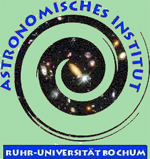Interstellar Medium in Galactic Halos
Dominik Bomans, Ralf-Jürgen
Dettmar, Jörn
Rossa, Ralph
Tüllmann
Our research programs investigate the various interaction processes
of the Interstellar Medium (ISM) in external galaxies. Specially we
are interested in the disk-halo interaction, that is the connection
between the star formation processes in the galaxy disks with the
observed gas outflows, which emanate into the halo of the galaxies
through supernova- or starburst-driven winds. These gas outflows,
which sometimes lead to extended diffuse ionized gas (DIG) layers,
can be observed in the optical wavelength regime with narrow-band
imaging and longslit spectroscopy techniques (e.g., H-Alpha, [NII],
[SII], [OIII]).
A mechanism for the gas transport from the disk into the halo has
been theoretically formulated by several authors, which include the
galactic fountains by Shapiro & Field (1976) and the chimney scenario by Norman & Ikeuchi (1989) depending on the escape velocity
of the gas. However, currently it is not clear what ionizational mechanisms
keep the gas ionized at the observed extraplanar distances up to ~
1-2 kpc (on average) above the galactic plane. Photoionization is
the most viable process. However, additional mechanisms such as shock-ionization,
turbulent mixing-layers may also play an important role.
The star formation activity in the underlying galaxy disks can be
traced by various observing techniques at different wavelengths, as
a result of the physical processes. Our research group basically investigate
the following constituents of the ISM.
- The diffuse ionized gas (DIG) or equally called the warm ionized
medium (WIM)
- The hot ionized medium (HIM), which can be studied in the X-ray
regime.
- Dust (can be ideally studied in edge-on galaxies, making use
of broadband imaging, e.g., B,V,R).
Galactic halos are observed in various types of galaxies. In our
Milky Way an extraplanar diffuse ionized gas layer has been detected
a few decades ago, which is now investigated in detail. This layer
is now known as the Reynolds-layer.
In external galaxies DIG was first discovered independently in the
famous edge-on spiral galaxy NGC 891 by Dettmar (1990), and Rand et
al. (1990). Since then DIG has been discovered in about two dozen
galaxies, showing various morphological features (e.g., layer, filaments,
loops, plumes, shells).
DIG has been discovered in several galaxy types such as
- Starburst galaxies (e.g., NGC253, M82)
- Normal (or quiescent) galaxies (e.g., NGC 891, NGC 4634)
- Irregular galaxies (e.g., NGC 2188, NGC 4449)
- Dwarf galaxies (e.g., I Zw 18, NGC 1569, IC 10)
Our specific research interests are:
- Diffuse ISM and dust in spiral galaxies (Ralf-Jürgen
Dettmar)
- Diffuse warm and hot ISM of the Magellanic Clouds and other low-mass
galaxies (Dominik
Bomans)
- Multiphase ISM investigation of the disk-halo interaction in
edge-on spiral galaxies (Jörn Rossa)
- Determination of the radiation field and metallicities in dwarf
galaxies (Ralph
Tüllmann)
